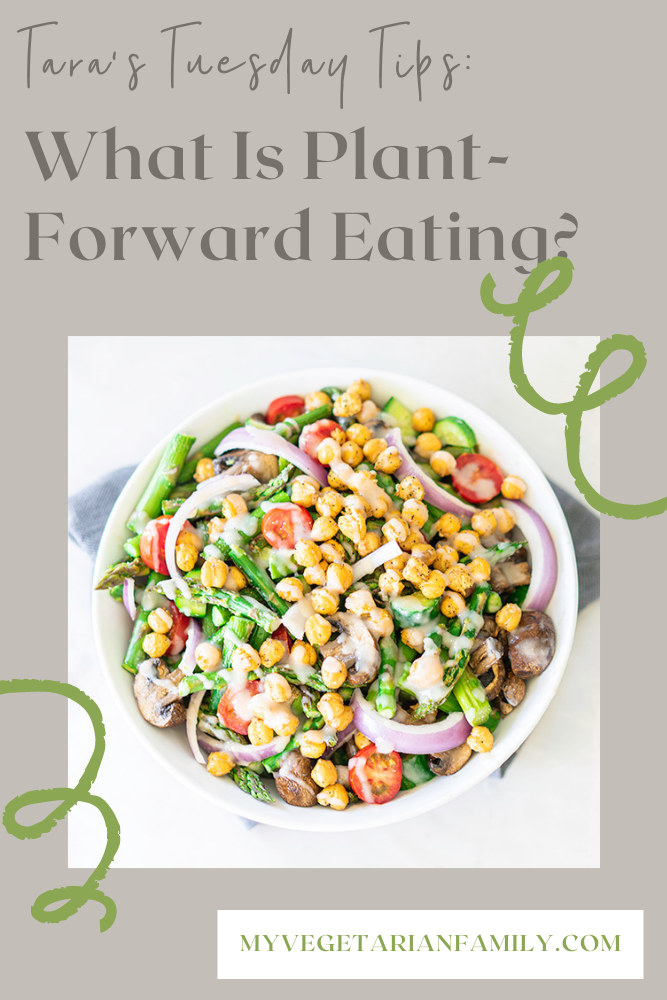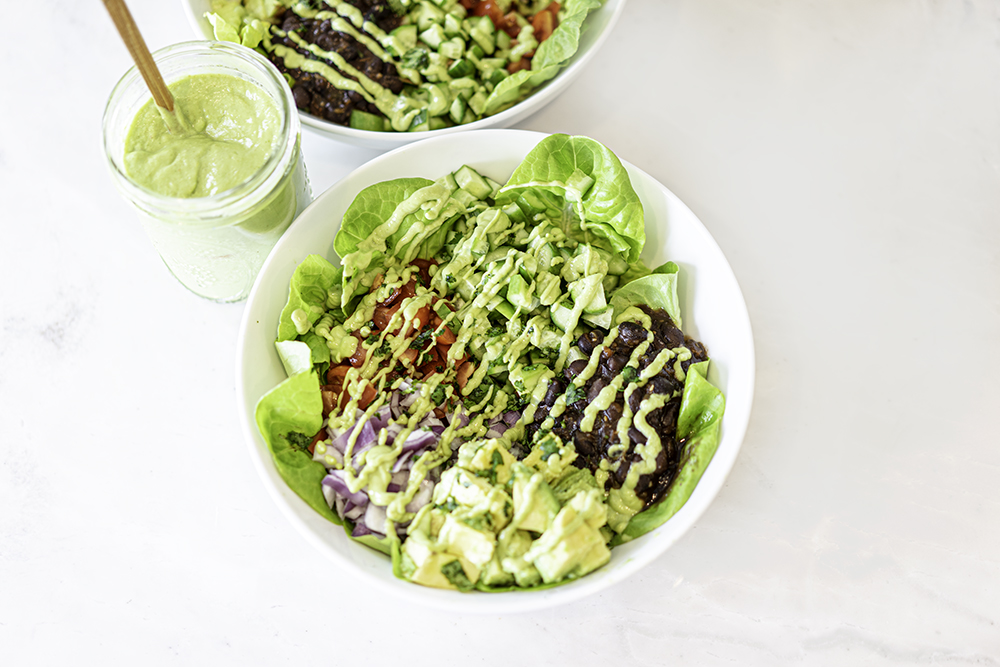Is one of your goals this year to eat less meat? How about to eat more plants or fiber or colorful + nutritious foods? A goal that adds things into your life instead of subtracting things?!?! Now that is a goal I can get on board with! Let me introduce you to something you might not be familiar with … plant-forward eating!
What Is Plant-Forward Eating?
Everyday eating that incorporates more plant-based foods. Getting more plants on your plate and in your cooking is the goal of a plant-forward approach to eating. This type of eating ranges from those that follow a strict vegan diet consuming no animal products to as simple as preparing meals that incorporate more plants + whole foods. Flexitarian and plant-forward are very similar. “Plant-rich” is another term used to describe this way of eating. By incorporating more plants, we tend to push aside the need for a high consumption of animal products. So, you aren’t necessarily restricting animal products, but with this way of eating you are leaving less room on your plate (and in your life) for them.
Why Should You Consider Eating
Plant-Forward?
Disease Prevention
Eating more plants in your everyday diet has been proven to help with weight loss, prevent and even reverse diabetes, heart disease, and other chronic health conditions. Still curious about how plant-based eating can help you prevent disease? Check out these tips: How To Eat To Prevent Diabetes, How to Lower Your Cholesterol, How To Eat For Heart Health!
Inflammation
There could be tremendous healing power in what we eat. Reducing the amount of meat you eat or ditching meat all together might will help you alleviate some of the ailments caused by inflammation in the body. Eating less animal products + more plants might be just enough help you need to diminish those nagging symptoms (aka plant-forward or plant-rich!). Think this might be you? Read this: Signs That You Should Go Plant-Based!
Environmental Impact
Eating plant-forward means adding more plants into whatever you cook, eat, and how you live. This pushes out the need for increased animal consumption, farming, and distribution. Plants require far less water + resources + leave a far less environmental footprint.
Financial Considerations
Whole plant foods cost far less than animal-based products especially with higher quality animal products. Having the meat or dairy or fish become the side dish or the topping instead of the main meal significantly brings down the price tag of your meals.
Plants Are Good Mood Foods
Fiber! Fiber! I can’t say this enough. A healthy gut microbiome leads to better cognition, mood, sleep, and more. A plant-forward style of eating helps you prioritize plants leaving less room for the animal products or processed foods that wreak havoc on your gut microbiome. Read all about this topic here: The Vegetarian’s Guide To Mood Boosting Foods!
What Is The Difference Between
Plant-Forward + Plant-Based?
The names are similar, but the eating style is very different! These are two opposite ends of the spectrum. Someone who considers themselves a strictly whole foods plant-based eater is someone who eats only foods that contain absolutely no animal products, and their diets are free from processed foods. This is very different from plant-forward! A plant-forward person tries to prioritize plants by looking for ways to use more plants in their cooking, centering meals around a plant with some animal products occasionally mixed in. There is no restriction in a plant-forward approach. Check this out: What Is A Whole Food, Plant-Based Diet?
Is Plant-Forward Eating A Fad Diet?
No way! People + communities have been plant-forward for centuries! The Mediterranean way of eating, Blue Zones, and many Adventist communities are great examples of plant-forward ways of eating. A plant-forward diet is not restrictive and therefore is much more sustainable than any other type of diet.
EASY Ways To Start Eating More Plant-Forward
This is not an all-or-nothing situation, and it is certainly not a fad diet. Contrary to restrictive diets, plant-forward allows you to add not subtract from your life. Try some of these tips to get you started:
Meatless Monday (or Tuesday or Wednesday or any day!)
The term ‘Meatless Monday’ launched over a decade ago with a simple philosophy – one day a week, ditch the meat. People everywhere participate in Meatless Mondays for personal health reasons or for the environmental impact. Whatever the reason to do it, it’s working to get people to eat more plants! Swap out your meat-centered meal for a veggie-centered meal on Mondays or whatever day works for you. Small changes add up, you might even like it and add a second meatless day to your week. Read more here: The Vegetarian’s Guide To Leafy Greens.
Pick a Plant + Plan A Meal Around It
Traditionally, family meals are planned around the meat (burger, chicken, steak, fish) and then the vegetable side dishes are an add-on. Instead, with a plant-forward diet, you pick a plant you are curious about (chickpeas, spaghetti squash, lentils, tofu), making the plant the center of attention. If you still want to add an animal product, it can simply be a side or a topping. Start here: Easy Ways To Eat More Plants!
Explore New Cuisines
Sometimes just getting out of our cooking rut will open the door to many, many, many easy ways to eat plant-forward. The more diversity you have in your cooking, the more plants you will eat. Swap out your favorite American cuisine for incredibly Indian dishes, Asian, and even Mexican and you will see how many more plants go into these recipes without you even thinking about making it plant-based!
Make Easy Swaps:
- Use egg alternatives when baking (How To Bake Without Eggs)
- Make nice cream in place of ice cream (Pumpkin Spice Nice Cream)
- Use a mashed avocado or hummus instead of mayo (Oil-Free Everything Bagel Hummus)
- Try incorporating nutritional yeast in place of cheese (Nutritional Yeast 101)
- Plant-based milk instead of dairy milk is a really easy one! (How To Choose A Dairy-Free Milk Alternative)
- Make a ‘cheesy’ sauce out of cauliflower or cashews or potatoes (Vegan Potato Cheese Sauce)
10 Easy Tips To Start Eating Plant-Forward
- Make a lettuce wrap (Jackfruit Mexican Lettuce Wraps)
- Make veggies easy to grab + go by washing and cutting them as soon as they make it in your door.
- Top your pizza with veggies (Vegan Buffalo Cauliflower Pizza)
- Sneak greens into baking (Healthy Eggless Zucchini Brownies)
- Keep your freezer stocked with frozen greens (Guide To Frozen Vegetables)
- Dunk your green veggie into a green veggie (Dairy Free Green Goddess Dressing)
- Blend away (Cilantro Jalapeño Hummus)
- Make soup (Quinoa Vegetable Soup: Instant Pot or Stove-Top)
- Introduce your air fryer to your green friends (Air Fryer Zucchini Fries)
- Use herbs! (Oil Free Air Fryer Potato Wedges)
Old Ways Won’t Open New Doors
Change is difficult. Very difficult. So, start small. You don’t have to finish reading this and commit to going vegan, vegetarian or switch to a completely whole food, plant-based diet. However, if you have finished reading this and realize it’s time to reset something in your life, remember your old ways need to change to open the new door.
One small change might ignite another small change and before you know it your old ways are changing, and you are on your way to letting food be your medicine. Consider giving up just one or two of your old animal-based eating habits. That, my friends, is plant-forward eating.
All The Best,
Tara 💚

⭐Are you ready to start Plant-Forward Eating? Leave a comment below! ⭐
📸I love to see your creations! Follow me on Instagram @myvegetarianfamily and hashtag it #myvegetarianfamily
💌Be sure to subscribe here to my weekly emails for tips and recipes so that you never miss a veggie thing!



